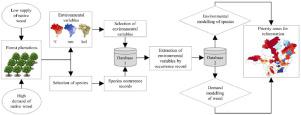当前位置:
X-MOL 学术
›
Ecol Modell
›
论文详情
Our official English website, www.x-mol.net, welcomes your feedback! (Note: you will need to create a separate account there.)
Potential planting areas for native tree species in minas gerais state, Brazil, based on environmental variables and wood demand
Ecological Modelling ( IF 3.1 ) Pub Date : 2020-09-01 , DOI: 10.1016/j.ecolmodel.2020.109211 Thales G.V. Martins , Geraldo G. Reis , Maria G.F. Reis , Lucas A.A. Telles , Mayara R. Lage , Gleidson G.C. Mendes , Dayane L. Pinto , Nero L.M. Castro , Alexandre S. Lorenzon , Ricardo S. Silva , Duberlí G.E. Gonzáles
Ecological Modelling ( IF 3.1 ) Pub Date : 2020-09-01 , DOI: 10.1016/j.ecolmodel.2020.109211 Thales G.V. Martins , Geraldo G. Reis , Maria G.F. Reis , Lucas A.A. Telles , Mayara R. Lage , Gleidson G.C. Mendes , Dayane L. Pinto , Nero L.M. Castro , Alexandre S. Lorenzon , Ricardo S. Silva , Duberlí G.E. Gonzáles

|
Abstract Wood production from native tree species in Brazil is primarily limited to exploitation of natural forests. The identification of potential habitats for tree planting may provide new opportunities for natural forest conservation and management and increase the viability of native species plantations for highly valuable wood production. This study aimed to identify potential habitats for native tree planting using a crop-zoning model that combines environmental variables and wood demand modeling. The target region for the study was Minas Gerais (MG) State, Southeast Region, Brazil. The MaxEnt model was used to match environmental variables and the occurrence of 19 economically important tree species. Wood demand modeling was performed through the Grouping Analysis algorithm, using Brazilian consumption records by species. The models generated with MaxEnt were highly accurate (area under the curve [AUC] ≥ 0.77). Apuleia leiocarpa (Vogel) J. F. Macbr., Hymenaea courbaril L., Micropholis venulosa (Mart. & E. ex Miq.) P., P., Pouteria caimito (Ruiz & Pav.) Radlk., Pouteria guianensis Aubl., Simarouba amara Aubl., and Tachigali paniculata Aubl. presented potential cultivation areas occupying 460,881, 572,467, 208,820, 202,989, 118,937, 158,254, and 288,769 km2, respectively. Three classes of wood demand were identified (R2 ≥ 0.82). The Belo Horizonte, Juiz de Fora, Montes Claros, and Uba micro-regions showed high demand for most species studied. The interaction between wood demand and areas with potential for planting each species allowed the specification of priority regions for reforestation. Regions with high demand and high cultivation potential occupied, in km², 19,993.23 for A. leiocarpa, 4,193.8 for H. courbaril, 1,939.6 for M. venulosa, 16,356.3 for P. caimito, 1,623.6 for P. guianensis, 0.8 for S. amara, and 53,566.2 for T. paniculata. Establishing these native tree species near wood-based industries in regions that match the environmental variables of their occurrence area leads to natural forest conservation and economic growth of consumption centers.
中文翻译:

基于环境变量和木材需求的巴西米纳斯吉拉斯州本地树种的潜在种植面积
摘要 巴西本地树种的木材生产主要限于天然林的开发。确定潜在的植树生境可能为天然森林的保护和管理提供新的机会,并提高本地物种种植园生产高价值木材的可行性。本研究旨在使用结合环境变量和木材需求模型的作物分区模型来确定本地树木种植的潜在栖息地。该研究的目标区域是巴西东南地区的米纳斯吉拉斯州 (MG)。MaxEnt 模型用于匹配环境变量和 19 种重要经济树种的出现情况。木材需求建模是通过分组分析算法进行的,使用巴西按物种分类的消费记录。使用 MaxEnt 生成的模型非常准确(曲线下面积 [AUC] ≥ 0.77)。Apuleia leiocarpa (Vogel) JF Macbr., Hymenaea courbaril L., Micropholis venulosa (Mart. & E. ex Miq.) P., P., Pouteria caimito (Ruiz & Pav.) Radlk., Pouteria guianensis Aubl., Simarouba amara Aubl. 和 Tachigali paniculata Aubl。提出的潜在种植面积分别为 460,881、572,467、208,820、202,989、118,937、158,254 和 288,769 平方公里。确定了三类木材需求(R2 ≥ 0.82)。Belo Horizonte、Juiz de Fora、Montes Claros 和 Uba 微型区域对大多数研究物种的需求量很大。木材需求与每个物种的种植潜力区域之间的相互作用允许指定重新造林的优先区域。高需求和高种植潜力的地区被占用,平方公里,A. leiocarpa 19,993.23,H. courbaril 4,193.8,M. venulosa 1,939.6,P. caimito 16,356.3,P. guianensis 1,623.6,S.5.6,5 panara 0.8,5.6 amara 在与其发生地区的环境变量相匹配的地区,在木材工业附近建立这些本地树种,可以促进天然林保护和消费中心的经济增长。
更新日期:2020-09-01
中文翻译:

基于环境变量和木材需求的巴西米纳斯吉拉斯州本地树种的潜在种植面积
摘要 巴西本地树种的木材生产主要限于天然林的开发。确定潜在的植树生境可能为天然森林的保护和管理提供新的机会,并提高本地物种种植园生产高价值木材的可行性。本研究旨在使用结合环境变量和木材需求模型的作物分区模型来确定本地树木种植的潜在栖息地。该研究的目标区域是巴西东南地区的米纳斯吉拉斯州 (MG)。MaxEnt 模型用于匹配环境变量和 19 种重要经济树种的出现情况。木材需求建模是通过分组分析算法进行的,使用巴西按物种分类的消费记录。使用 MaxEnt 生成的模型非常准确(曲线下面积 [AUC] ≥ 0.77)。Apuleia leiocarpa (Vogel) JF Macbr., Hymenaea courbaril L., Micropholis venulosa (Mart. & E. ex Miq.) P., P., Pouteria caimito (Ruiz & Pav.) Radlk., Pouteria guianensis Aubl., Simarouba amara Aubl. 和 Tachigali paniculata Aubl。提出的潜在种植面积分别为 460,881、572,467、208,820、202,989、118,937、158,254 和 288,769 平方公里。确定了三类木材需求(R2 ≥ 0.82)。Belo Horizonte、Juiz de Fora、Montes Claros 和 Uba 微型区域对大多数研究物种的需求量很大。木材需求与每个物种的种植潜力区域之间的相互作用允许指定重新造林的优先区域。高需求和高种植潜力的地区被占用,平方公里,A. leiocarpa 19,993.23,H. courbaril 4,193.8,M. venulosa 1,939.6,P. caimito 16,356.3,P. guianensis 1,623.6,S.5.6,5 panara 0.8,5.6 amara 在与其发生地区的环境变量相匹配的地区,在木材工业附近建立这些本地树种,可以促进天然林保护和消费中心的经济增长。



























 京公网安备 11010802027423号
京公网安备 11010802027423号